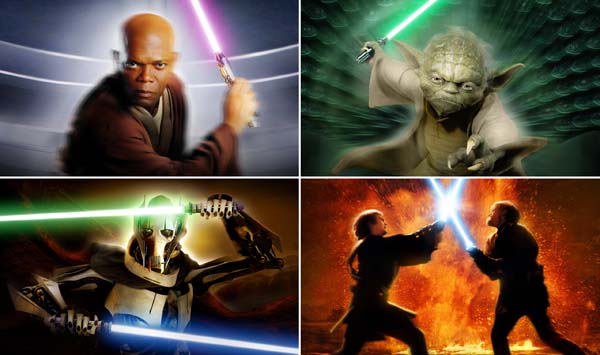BitDepth 475 - May 31
11/01/09 17:43 Filed in: BitDepth - May 2005
Starwars III, the final episode in George Lucas' space opera is done.
The heavy breathing begins

A flashing of sabres as (clockwise) Mace Windu redeems black actors in the Star Wars Universe, Yoda sets his puppet days behind him forever, Vader and Obi-Wan set it on fire and Grievous demonstrates what the modern cyborg wears in dangerous climates.
Star Wars is done. Mr Lucas has finished his grand epic of space opera 28 years after he began, and the circle, as his tragic protagonist would say, is complete.
It’s been such a long time and of late, such a torturous journey that it’s easy to forget where this all began, with a promising young director at the start of his career and a tall actor in a terrifying black suit.
It’s even more surprising to realise that the films weren’t about Luke Skywalker at all, the story is really about Anakin, whose cycle of blustery success and agonising failures would tempt a weak critic to see parallels between that tale and the saga of Lucas himself.
Well, call me enfeebled, but I see that link more clearly than ever with Revenge of the Sith, a movie that offers us a George Lucas more in charge of his craft than he has been since he began his Skywalker story.
We’ve long lost the director who might have made another intriguing movie after Star Wars in 1977, to the awesome industry that film’s success created. THX 1138 in 1971 and American Graffiti in 1973 were the work of a craftsman who worked easily with his actors even as he worked to find his style as a director.
Star Wars handily derailed all that and instead of being a formative step in the career of a new writer-director, became instead an engine of change that would touch every movie that came after it. From the sound engineering work at Skywalker Sound to the almost ubiquitous special effects wizardry of Industrial Light and Magic, Lucas and his films changed the American film industry.
His return to the subject matter in 1999 was less important for the actual film he produced than it was for its business model. George Lucas, you see, was the ultimate independent film maker.
He used his own money, selling merchandising opportunities to dozens of eager companies and offered the film to 20th Century Fox for distribution, the company that released the 1970’s Star Wars trilogy, but he didn’t have to.
The disappointments of The Phantom Menace, with an annoying Jake Lloyd as the child Anakin and the incredible blind spot of Jar Jar Binks, offered testimony to the remoteness and isolation that Lucas seemed to have created around him after his unprecedented success.
Its successor, Attack of the Clones, with a wooden Hayden Christensen as troubled teen Anakin, did little to reverse the trend.
Somehow, the director who had vaulted Ron Howard, Robert Duvall and Harrison Ford to public notice seemed to have lost his knack for directing people and his direction of the romance between Padmé Amidala (Natalie Portman) and Anakin had all the grace and intimacy of an exterminator removing a long dead boa constrictor with tongs.
Lucas the writer sees to be struggling to bring some resonance of the politics of the day in Sith, with a proud Republic fighting an obvious foe even as it is destroyed from within, but he just can’t get the allusions right, so it’s best to just forget about it and enjoy the numerous battles.
Despite these glaring failings, Lucas seemed to remember who he was with this film, reflecting often throughout the 140 minutes of its duration on the sweeter, more memorable moments of his first trilogy.
For the serious fan, these moments are far more subtle than Padmé newest weird hairstyling choice of dual buns. They range from a carefully shadowed echoing of the final showdown between Luke, Vader and the Emperor as Mace Windu and the Emperor-to-be battle for Anakin’s soul, to the immediately familiar interiors of Bail Organa’s ship, which is spanking white and ready for angry stormtrooper boots and blaster fire.
Surprisingly, in the one film in which we already know the end, Lucas, both as writer and director, manages to capture with a skill that’s pleasantly surprising Anakin’s wavering between his passion for Padmé and a growing lust for power.
Even if Christensen plays his descent into villainy as a series of pouts and empty glares, Lucas surrounds him with such a sense of mordant claustrophobia that his final decision, accompanied by the first stirrings of John Williams' magnificent Vader's March, seem preordained a far away and long ago God.
And Lucas can still milk a money shot. As the helmet clamps into place over the battered, burned head of Anakin Skywalker, there is a long, careful moment of absolute silence before we hear that first, struggling, raspy breath of a new and dangerous life. At this point, Globe’s rowdy crowds erupted, releasing the catharsis of Vader’s birth with rowdy, enthusiastic cheers.
Echoes of distant Wars
As Anakin Skywalker battles Count Dooku, Chancellor Palpatine sits in a lush black chair mirroring a pose he would be found in several times in both Empire and Return.
Harrison Ford’s famous line from the first trilogy, “I have a bad feeling about this” is practically a refrain.
Look carefully at the flunky who talks to the new Vader and the Emperor as they watch the Deathstar under construction. It must have taken a while to find someone who looked like almost exactly like a young Peter Cushing.
Evidently, the price of being a Darth of the Sith or being considered for one is an injury to the limbs. Anakin, Dooku, Grievous and in the curious “future” of these films, Luke, all lose hands in their lightsabre battles. No offscreen slashings for these Force users.

A flashing of sabres as (clockwise) Mace Windu redeems black actors in the Star Wars Universe, Yoda sets his puppet days behind him forever, Vader and Obi-Wan set it on fire and Grievous demonstrates what the modern cyborg wears in dangerous climates.
Star Wars is done. Mr Lucas has finished his grand epic of space opera 28 years after he began, and the circle, as his tragic protagonist would say, is complete.
It’s been such a long time and of late, such a torturous journey that it’s easy to forget where this all began, with a promising young director at the start of his career and a tall actor in a terrifying black suit.
It’s even more surprising to realise that the films weren’t about Luke Skywalker at all, the story is really about Anakin, whose cycle of blustery success and agonising failures would tempt a weak critic to see parallels between that tale and the saga of Lucas himself.
Well, call me enfeebled, but I see that link more clearly than ever with Revenge of the Sith, a movie that offers us a George Lucas more in charge of his craft than he has been since he began his Skywalker story.
We’ve long lost the director who might have made another intriguing movie after Star Wars in 1977, to the awesome industry that film’s success created. THX 1138 in 1971 and American Graffiti in 1973 were the work of a craftsman who worked easily with his actors even as he worked to find his style as a director.
Star Wars handily derailed all that and instead of being a formative step in the career of a new writer-director, became instead an engine of change that would touch every movie that came after it. From the sound engineering work at Skywalker Sound to the almost ubiquitous special effects wizardry of Industrial Light and Magic, Lucas and his films changed the American film industry.
His return to the subject matter in 1999 was less important for the actual film he produced than it was for its business model. George Lucas, you see, was the ultimate independent film maker.
He used his own money, selling merchandising opportunities to dozens of eager companies and offered the film to 20th Century Fox for distribution, the company that released the 1970’s Star Wars trilogy, but he didn’t have to.
The disappointments of The Phantom Menace, with an annoying Jake Lloyd as the child Anakin and the incredible blind spot of Jar Jar Binks, offered testimony to the remoteness and isolation that Lucas seemed to have created around him after his unprecedented success.
Its successor, Attack of the Clones, with a wooden Hayden Christensen as troubled teen Anakin, did little to reverse the trend.
Somehow, the director who had vaulted Ron Howard, Robert Duvall and Harrison Ford to public notice seemed to have lost his knack for directing people and his direction of the romance between Padmé Amidala (Natalie Portman) and Anakin had all the grace and intimacy of an exterminator removing a long dead boa constrictor with tongs.
Lucas the writer sees to be struggling to bring some resonance of the politics of the day in Sith, with a proud Republic fighting an obvious foe even as it is destroyed from within, but he just can’t get the allusions right, so it’s best to just forget about it and enjoy the numerous battles.
Despite these glaring failings, Lucas seemed to remember who he was with this film, reflecting often throughout the 140 minutes of its duration on the sweeter, more memorable moments of his first trilogy.
For the serious fan, these moments are far more subtle than Padmé newest weird hairstyling choice of dual buns. They range from a carefully shadowed echoing of the final showdown between Luke, Vader and the Emperor as Mace Windu and the Emperor-to-be battle for Anakin’s soul, to the immediately familiar interiors of Bail Organa’s ship, which is spanking white and ready for angry stormtrooper boots and blaster fire.
Surprisingly, in the one film in which we already know the end, Lucas, both as writer and director, manages to capture with a skill that’s pleasantly surprising Anakin’s wavering between his passion for Padmé and a growing lust for power.
Even if Christensen plays his descent into villainy as a series of pouts and empty glares, Lucas surrounds him with such a sense of mordant claustrophobia that his final decision, accompanied by the first stirrings of John Williams' magnificent Vader's March, seem preordained a far away and long ago God.
And Lucas can still milk a money shot. As the helmet clamps into place over the battered, burned head of Anakin Skywalker, there is a long, careful moment of absolute silence before we hear that first, struggling, raspy breath of a new and dangerous life. At this point, Globe’s rowdy crowds erupted, releasing the catharsis of Vader’s birth with rowdy, enthusiastic cheers.
Echoes of distant Wars
As Anakin Skywalker battles Count Dooku, Chancellor Palpatine sits in a lush black chair mirroring a pose he would be found in several times in both Empire and Return.
Harrison Ford’s famous line from the first trilogy, “I have a bad feeling about this” is practically a refrain.
Look carefully at the flunky who talks to the new Vader and the Emperor as they watch the Deathstar under construction. It must have taken a while to find someone who looked like almost exactly like a young Peter Cushing.
Evidently, the price of being a Darth of the Sith or being considered for one is an injury to the limbs. Anakin, Dooku, Grievous and in the curious “future” of these films, Luke, all lose hands in their lightsabre battles. No offscreen slashings for these Force users.
blog comments powered by Disqus

